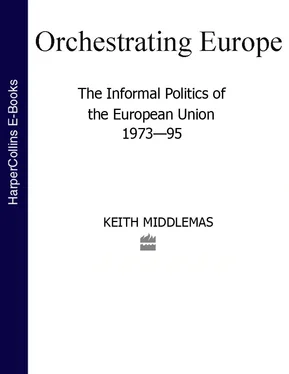It may not be possible until the documents are available to say certainly which of the actors was the prime mover or indeed whether the explanation should focus on circumstances rather than participants. Quite possibly it will depend on which segment of the wider process is examined. As can be seen from the next chapter, claims can be made for each of the main players. What matters more is that the combination of external challenges to the EC, the 1973 oil shock and strategic fears, the harsh recession and a pervasive disillusion with the system as it had stagnated, led to the entry of more and more players to the arena, while those already in it found a deeper commitment necessary. Their networks expanded and became denser, more continuously effective, notably in industries most threatened by foreign competition: cars, textiles, chemicals, electronics and steel producers. Similar developments, bringing in the same players, were taking place concurrently in many, if not most, national political systems.
Large and multinational firms had sought influence at the EC’s centre but had not been present on this scale before the 1970s, nor switched so much of their corporate resources from national to Community level. Financial institutions, which already watched the process, would follow once the internal market was seen to involve services and monetary union (EMU). 65They did not of course outweigh member states or Community institutions because they were not competing on the same level, nor usually for the same ends, but as the temporary failure at Athens demonstrated, the conjunction of all these was needed before regeneration could take place in the annus mirabilis of 1985.
New linkages were growing among the states; between France and Italy, France and Ireland, Germany and Italy, and in the core of those countries whose currencies followed the DM. Some even believed it possible that Britain might become a normal partner. A new world economic boom had started, which seemed matched in political terms by the arrival in power of Mikhail Gorbachev in March 1985: Gorbachev, whose aims had been hinted at earlier, both by his own speeches in England in December 1984, and in Russia by the fact that he had been manifestly the candidate of Yuri Andropov and those reformers who envisaged regeneration arising from a reborn Soviet state.
When President-Designate of the Commission Delors visited each of the other nine members’ capitals in the late autumn of 1984, he put four proposals (rather in the Monnet manner, ‘Europe is in a mess – where do we start?’) Only on the internal market were there signs of general consensus. Whatever conjunction existed at the EC centre (i.e., whenever ministers and heads of government met) was not yet matched in their domestic contexts. The process was neither secret nor predetermined: it operated on many levels with disjunctions, and moved like evolution itself, in fits and starts – more fits at IG level, more starts at official. Some hopes turned into dead-ends, like the Adonnino report; others, like the Dooge Report or the new language of ‘cohesion’ 66proved unexpectedly fruitful. There was no prime mover, and there were no obvious state boundaries within which the game could take place. But the players, wittingly or not, had begun to create them.
4
Making the Market: The Single European Act, 1980–88
Like cooling steel, recent history sets easily into patterns which then resist remoulding. The combination of media reports, expert and specialized commentaries, interviews, articles and memoirs, leads to a received wisdom which successive generations of political scientists, contemporary historians and biographers advance piecemeal. Some seek for a synthesis from which to theorize, others highlight what they take to be particularly significant episodes or individuals. At present, the consensus suggests that the Community experienced a great regeneration around 1985 with the Single Market White Paper serving as its dynamo; then, in a mood of euphoria, member states and the Commission took a leap at Maastricht, which they knew to be contingent on the internal market, only to find themselves isolated from their national publics and from each other. Recession and political disarray followed hand in hand.
Chapter 3suggested that a variety of players at different levels of activity were engaged, as early as 1980–81, in a struggle to break out of the inertia which had blanketed EC activity since the first oil shock. But what were the aims of each of these, and who contributed most, in that exuberant period after Fontainebleau?
The fact that EC archives are not yet available is not an insuperable difficulty, but it makes it harder to separate underlying trends from less significant details. It is not clear, for example, whether the oligopolistic tendencies among firms in this stagnant decade were caused by the failure of small and medium companies to adapt quickly enough, or by large ones exercising their advantage through concentration and monopoly power, often in collusion with their national governments. Yet the internal market was advocated by players who took the latter assumption for granted, together with its logical extension to the concept of a single currency. Nor is it obvious that the Single European Act was the only way to remedy the collusive, anti-competitive state of mind which appeared to envelop European business and industry in the face of the American and Japanese challenges.
The account given here takes a historical perspective on a very complex and still-continuing process; and is intended to show not only the relative importance of the players (the Commission, member states, the European Parliament, industrial or financial bodies) but their motivation at the time. Seen in this way, the significant points in the narrative are those where the greatest measure of agreement was reached between them, prior to more public action.
In the second half of 1984, following the breakthrough at Fontainebleau, the British budgetary question had apparently been resolved, the EC’s financial system had been unblocked, aspects of the CAP, such as the wine market, had been reformed, and the Regional Development Fund expanded. The Esprit Programme introduced a more coherent policy on technology, while the single customs document launched a substantial assault on frontier barriers. Jacques Delors, an ardent integrationist with a considerable reputation as former French finance minister, had been chosen as the new President of the Commission. He could in turn be expected to demand a higher standard of Commissioners and overall competence than had been the case in the previous ten years.
The recession had also ended, providing a two-fold spur to activity: firstly because of the upturn in global demand and secondly because so little had been done since the mid–70s crisis to improve European industry’s competitive performance vis-à-vis the United States and Japan. General economic convergence led member states towards a common awareness of the likelihood of takeovers looming from outside the EC, and the continuing loss of EC companies’ share of world and European markets. Meanwhile, as international trade recovered, the EC’s defensive strategies and member states’ endemic lapses into protectionism came under fiercer scrutiny, particularly from the USA, where American trade negotiators in the Reagan administration began to use much rougher language towards both the EC and Japan than they had under President Carter; but also from Britain, where inflation control, privatization of state industries, and widespread assaults on the labour market were becoming the keynotes of a novel sort of industrial regime – one which Mitterrand’s 1983 turnabout suggested other EC states might conceivably follow. On a more general level, the development of competition law and its enforcement, mainly in Germany (for France and Italy barely had a competition policy other than the one the Commission tried to police), 1led to a climate in which linkages became possible between what the German government was trying to achieve and the Commission’s long-term industrial policy. American and Swiss companies in the EC soon became aware of this new climate, generally earlier than their EC national counterparts.
Читать дальше









![Brian Thompson - A Monkey Among Crocodiles - The Life, Loves and Lawsuits of Mrs Georgina Weldon – a disastrous Victorian [Text only]](/books/704922/brian-thompson-a-monkey-among-crocodiles-the-life-thumb.webp)


